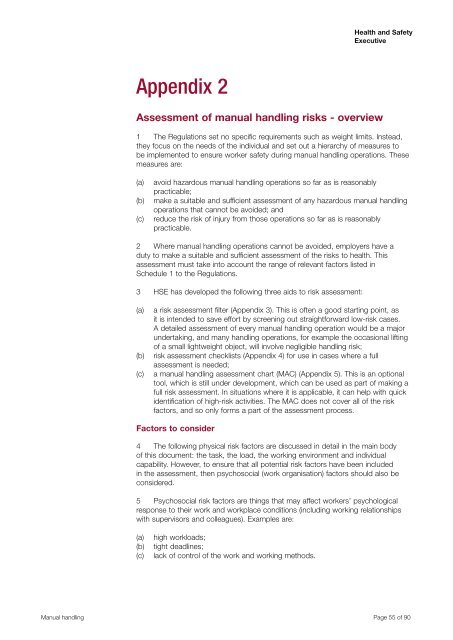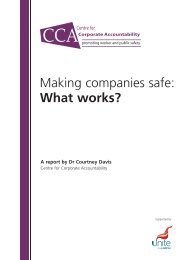Manual Handling Manual Handling Operations Regulations 1992 ...
Manual Handling Manual Handling Operations Regulations 1992 ...
Manual Handling Manual Handling Operations Regulations 1992 ...
Create successful ePaper yourself
Turn your PDF publications into a flip-book with our unique Google optimized e-Paper software.
Health and Safety<br />
Executive<br />
Appendix 2<br />
Assessment of manual handling risks - overview<br />
1 The <strong>Regulations</strong> set no specific requirements such as weight limits. Instead,<br />
they focus on the needs of the individual and set out a hierarchy of measures to<br />
be implemented to ensure worker safety during manual handling operations. These<br />
measures are:<br />
(a)<br />
(b)<br />
(c)<br />
avoid hazardous manual handling operations so far as is reasonably<br />
practicable;<br />
make a suitable and sufficient assessment of any hazardous manual handling<br />
operations that cannot be avoided; and<br />
reduce the risk of injury from those operations so far as is reasonably<br />
practicable.<br />
2 Where manual handling operations cannot be avoided, employers have a<br />
duty to make a suitable and sufficient assessment of the risks to health. This<br />
assessment must take into account the range of relevant factors listed in<br />
Schedule 1 to the <strong>Regulations</strong>.<br />
3 HSE has developed the following three aids to risk assessment:<br />
(a)<br />
(b)<br />
(c)<br />
a risk assessment filter (Appendix 3). This is often a good starting point, as<br />
it is intended to save effort by screening out straightforward low-risk cases.<br />
A detailed assessment of every manual handling operation would be a major<br />
undertaking, and many handling operations, for example the occasional lifting<br />
of a small lightweight object, will involve negligible handling risk;<br />
risk assessment checklists (Appendix 4) for use in cases where a full<br />
assessment is needed;<br />
a manual handling assessment chart (MAC) (Appendix 5). This is an optional<br />
tool, which is still under development, which can be used as part of making a<br />
full risk assessment. In situations where it is applicable, it can help with quick<br />
identification of high-risk activities. The MAC does not cover all of the risk<br />
factors, and so only forms a part of the assessment process.<br />
Factors to consider<br />
4 The following physical risk factors are discussed in detail in the main body<br />
of this document: the task, the load, the working environment and individual<br />
capability. However, to ensure that all potential risk factors have been included<br />
in the assessment, then psychosocial (work organisation) factors should also be<br />
considered.<br />
5 Psychosocial risk factors are things that may affect workers’ psychological<br />
response to their work and workplace conditions (including working relationships<br />
with supervisors and colleagues). Examples are:<br />
(a)<br />
(b)<br />
(c)<br />
high workloads;<br />
tight deadlines;<br />
lack of control of the work and working methods.<br />
<strong>Manual</strong> handling Page 55 of 90
















